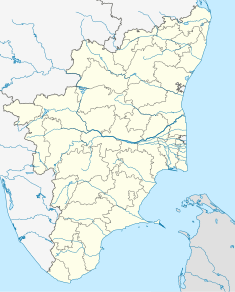m (→External links: Remove some templates. interwiki links and cleanup) |
(→top: Remove some templates and interwiki links, delink non military terms and cleanup) Tag: apiedit |
||
| (6 intermediate revisions by 2 users not shown) | |||
| Line 14: | Line 14: | ||
| designation1_free2name = Region |
| designation1_free2name = Region |
||
| designation1_free2value = |
| designation1_free2value = |
||
| − | | location = [[Kanyakumari]], |
+ | | location = [[Kanyakumari]], India |
| elevation = |
| elevation = |
||
| built = |
| built = |
||
| Line 28: | Line 28: | ||
}} |
}} |
||
| − | '''Vattakottai Fort''' (or 'Circular Fort') is a seaside fort near |
+ | '''Vattakottai Fort''' (or 'Circular Fort') is a seaside fort near Kanyakumari, [[TamilNadu]] the southern tip of India. It was built in the 18th century as a coastal defence-fortification and barracks in the erstwhile [[Travancore]] kingdom. |
| − | It was constructed under the supervision of Captain [[Eustachius De Lannoy]], an ex-Dutch naval officer of the |
+ | It was constructed under the supervision of Captain [[Eustachius De Lannoy]], an ex-Dutch naval officer of the Dutch East India Company, who became commander of the Travancore Army (the very army that defeated him in the [[Battle of Colachel]]) in the 18th century, after he earned the trust of the Travancore King [[Marthanda Varma]]. De Lannoy constructed Vattakottai, as part of the defence-fortifications he undertook throughout Travancore. |
The fort is made of granite blocks and, today, a part of the fort extends into the sea. It is a protected site under the Indian archaeological department. A major renovation of the fort was undertaken recently by the department, and the site is now a popular tourist spot. |
The fort is made of granite blocks and, today, a part of the fort extends into the sea. It is a protected site under the Indian archaeological department. A major renovation of the fort was undertaken recently by the department, and the site is now a popular tourist spot. |
||
| − | Vattakottai Fort commands a picturesque view of both the sea on the one side, and the hills ([[Western Ghats]]) on the other. Another interesting feature near the site is a beach of black sands. It is about {{convert|7|km|abbr=on}} from |
+ | Vattakottai Fort commands a picturesque view of both the sea on the one side, and the hills ([[Western Ghats]]) on the other. Another interesting feature near the site is a beach of black sands. It is about {{convert|7|km|abbr=on}} from Kanyakumari town. |
| − | == |
+ | ==Photo gallery== |
<gallery> |
<gallery> |
||
| − | + | File:Vattakottai Fort.jpg|Inside of the fort. |
|
| − | + | File:Vattakottai Fort - Highest Level Facing Sea.JPG|Elevated level of the fort, facing the sea. |
|
| − | + | File:Hill-View from Vattakottai Fort.JPG|View of the hills from Vattakottai fort. |
|
| − | + | File:View from Vattakottai Fort.JPG|View of the sea from Vattakottai fort. |
|
</gallery> |
</gallery> |
||
| − | == |
+ | ==External links== |
{{Commons}} |
{{Commons}} |
||
* [http://www.hindu.com/mp/2004/05/01/stories/2004050100210100.htm Forgotten fort Vattakottai: Elegant and steeped in history] |
* [http://www.hindu.com/mp/2004/05/01/stories/2004050100210100.htm Forgotten fort Vattakottai: Elegant and steeped in history] |
||
| Line 50: | Line 50: | ||
* [http://photosynth.net/view.aspx?cid=44ed1346-6f6e-45db-b56d-5f1e10745b6a Vattakottai in 3D view] |
* [http://photosynth.net/view.aspx?cid=44ed1346-6f6e-45db-b56d-5f1e10745b6a Vattakottai in 3D view] |
||
| − | {{Regions of Kanyakumari}} |
||
{{Forts in Tamil Nadu}} |
{{Forts in Tamil Nadu}} |
||
| + | |||
| + | {{Wikipedia|Vattakottai Fort}} |
||
[[Category:History of Kerala]] |
[[Category:History of Kerala]] |
||
Latest revision as of 00:54, 22 April 2016
| Vattakottai Fort | |
|---|---|
| [[File:{{{image_name}}}|250px|]] | |
| Location | Kanyakumari, India |
| Coordinates | 8°07′30″N 77°33′54″E / 8.125°N 77.565°E |
| Type | Cultural |
| State Party |
|
Vattakottai Fort (or 'Circular Fort') is a seaside fort near Kanyakumari, TamilNadu the southern tip of India. It was built in the 18th century as a coastal defence-fortification and barracks in the erstwhile Travancore kingdom.
It was constructed under the supervision of Captain Eustachius De Lannoy, an ex-Dutch naval officer of the Dutch East India Company, who became commander of the Travancore Army (the very army that defeated him in the Battle of Colachel) in the 18th century, after he earned the trust of the Travancore King Marthanda Varma. De Lannoy constructed Vattakottai, as part of the defence-fortifications he undertook throughout Travancore.
The fort is made of granite blocks and, today, a part of the fort extends into the sea. It is a protected site under the Indian archaeological department. A major renovation of the fort was undertaken recently by the department, and the site is now a popular tourist spot.
Vattakottai Fort commands a picturesque view of both the sea on the one side, and the hills (Western Ghats) on the other. Another interesting feature near the site is a beach of black sands. It is about 7 km (4.3 mi) from Kanyakumari town.
Photo gallery
External links
| Wikimedia Commons has media related to Vattakottai Fort. |
- Forgotten fort Vattakottai: Elegant and steeped in history
- Facelift planned for Vattakottai
- Vattakottai in 3D view
| |||||
The original article can be found at Vattakottai Fort and the edit history here.




